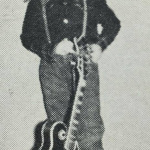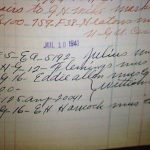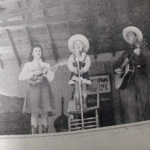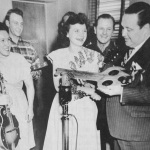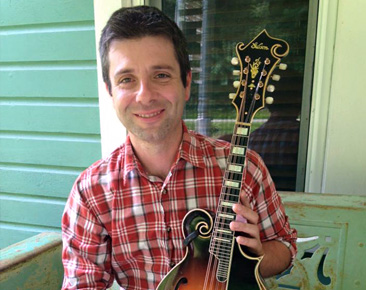
 Does every instrument have a story to tell? That’s a romantic notion among musicians and many fans of acoustic stringed music, imagining all the people who may have played or owned one over its life.
Does every instrument have a story to tell? That’s a romantic notion among musicians and many fans of acoustic stringed music, imagining all the people who may have played or owned one over its life.
That theme was the basis for a popular film in 1998 called The Red Violin, a fictional story which followed a classic violin across four centuries and three continents. Though based on a famous Stradivarius known for its red markings, the violin in the story was a fanciful tale of a 17th century violin maker who infused his beloved wife’s blood into the finish as both she and her unborn child had died.
The legend in the film suggested that this finish contained both a tragic curse for the owner and excellent sonic properties for the instrument which are revealed across the years. With scenes shot across Europe and China, and music performed by Joshua Bell, The Red Violin was a hit with critics and won an Academy Award for its score.
Lovers of vintage instruments are legion in the bluegrass and old time music world. Some of the factory-made classics that are most prized in our music are creeping up on 100 years of age, and players lucky enough to own them are nearly always happy to stop and chat about their mandolins, guitars, and banjos and what they may know about the instruments’ backgrounds.
Fiddles and basses also have stories, though violin makers in particular are so varied, and so many that end up as fiddles are made as copies of famous instruments, that they are more difficult to trace. But the fretted family of acoustics tend to have been made in small shop or factory settings, with serialization and shipping records to verify their provenance.
In discussing a number of recent stories with Scott Napier, mandolinist with Lost and Found and instructor at the Kentucky School of Bluegrass and Traditional Music in Hazard, KY, we also found ourselves talking about his primary instrument, a 1939 Gibson F5 mandolin which he acquired last fall.
Scott is something of a history buff, and spent a good bit of time researching this mandolin, tracing it back to its original owner in Pennsylvania, Jane Claar, and even met with her daughter Connie to see old photos of the instrument in professional use in the 1940s and ’50s. It struck me as a fascinating story that would interest our readers as well.
 This instrument is what is commonly known as having a “block style” inlay, with rectangles of pearl that fill the fret spaces where they are installed. Some pickers call them “Bush style,” as Sam Bush has historically played one of these, and Gibson has made a Sam Bush signature model mandolin using this pattern for several years.
This instrument is what is commonly known as having a “block style” inlay, with rectangles of pearl that fill the fret spaces where they are installed. Some pickers call them “Bush style,” as Sam Bush has historically played one of these, and Gibson has made a Sam Bush signature model mandolin using this pattern for several years.
Scott said that his interest in the history of this F5 was piqued when he noticed some custom features on this ’39. The Gibsons from this period usually had a thicker and wider neck, something continued in the newer Bush model F5s, but the one Napier had recently obtained did not. It also had an engraved tailpiece that wasn’t stock in the late ’30s. He began to wonder whether the mandolin had been ordered custom from the Gibson factory in Michigan, or if it was simply a one off.
So he started checking with friends in the vintage instrument collectors world, including Larry Cadle and Mitch Simpson who had owned it before Scott got it. In fact, Scott gives a lot of credit to Larry who made it feasible for him to get this instrument.
“Larry made it possible for me to get it. He actually made it impossible for me to not get it.
I had first played the mandolin over July 4 last year when I did a gig with him, and he agreed to let me borrow it for the summer. By October we had arranged a deal that allowed me to purchase it from him. It was too good to refuse.”
They looked over Gibson shipping records for the period, and found that while this F5 was built in 1939, it wasn’t shipped to a dealer until 1941. Good fortune allowed him to make this determination, as a major part of the company’s shipping records were destroyed in a fire, but Scott said that John Thomas of Fretboard Journal had copies of the records for ’39-’41.
These records indicate that the mandolin shipped on July 10, 1941 to Julius Music House in York, Pennsylvania. The serial number in this record (EA-5192) matches the one on the label in Scott’s F5. So he knew when it was sold to a dealer, but had no idea who had been the original owner, and Julius Music House was no longer in operation.
 In its day, the Music House had been a large and successful music retailer, run by Stuart Julius, who was a popular tenor banjoist in the 1920s. He opened the business when he came off the road, and had a three-story facility at 143 Market Street with a retail store on the first floor and music lessons offered upstairs.
In its day, the Music House had been a large and successful music retailer, run by Stuart Julius, who was a popular tenor banjoist in the 1920s. He opened the business when he came off the road, and had a three-story facility at 143 Market Street with a retail store on the first floor and music lessons offered upstairs.
While doing research online, he came across a photo of The Western Vagabonds, a cowboy band that was based in York during the 1940s. In the photo, he saw their mandolinist, Jane Claar, playing an F5 with block inlays. Looking closer, a note associated with the photo mentioned that in the picture, she was playing her “newly acquired Gibson mandolin.” When he saw that it was dated 1941, he felt sure that he had found the original owner. Knowing that his mandolin had an engraved truss rod cover with the initials “J.C.” was the clincher.
Some further digging turned up that the Vagabonds had included Jane Claar and her husband, Jim, and that they performed professionally for many years. By this time, they had both passed but Napier located their daughter Connie Rose Claycomb who, while initially a bit unsure about the young man calling to ask about her mother’s mandolin, soon warmed to his questions and eventually welcomed Scott to visit her at home.
“The Western Vagabonds helped run Shorty Fincher’s Valley View Park, and at the end of every show all of the artists on the show would get up together on stage. I have photos of them with the Sons of the Pioneers and Roy Rogers and other western acts. They were great friends with The Carter Family, and Connie said that Maybelle and her mother played this mandolin whenever they got together.
Connie also remembered watching them play a show with Hank Williams. When her dad passed in ’91, Connie wrote a booklet in remembrance of her parents and left it in the case. She recalls her mom saying that she used to lay in the case as a baby, dressed in a cowboy uniform.”
It was this booklet Scott found in the case that allowed him to track her down. She had included her address and phone number in the back, and when Scott called 25 years later, Connie picked up the phone. Since then they have exchanged pictures and stories, and Scott made a trip to visit Connie around Christmas last year. When Lost and Found played near York a few weeks ago, Napier took a side trip to see the former site of Julius Music House, and Connie came out to the show to hear her mother’s mandolin be played again. It was a grand reunion.
 Scott also discovered that he is only the third player to own this instrument. When Jim Claar died, Jane sold it on to a west coast musician, Kerry Williams, who was the mandolinist for Django’s Cadillac. They were a sort of alternative swing band in the ’90s, and Scott turned up a photo of them with Kerry holding the mandolin. To make it even more surreal, Scott realized that he owned the one album they had recorded back then, and remembered how much he had admired the mandolin tone on that record!
Scott also discovered that he is only the third player to own this instrument. When Jim Claar died, Jane sold it on to a west coast musician, Kerry Williams, who was the mandolinist for Django’s Cadillac. They were a sort of alternative swing band in the ’90s, and Scott turned up a photo of them with Kerry holding the mandolin. To make it even more surreal, Scott realized that he owned the one album they had recorded back then, and remembered how much he had admired the mandolin tone on that record!
Napier shared a few more of the photos he has of his mandolin in its younger days.
What a remarkable story, and hats off to Scott for doing the research, to Connie Claycomb for memorializing her parents with a booklet, and to all those who subsequently transferred ownership of the mandolin for keeping the booklet in the case.
Don’t you all wish you had such a detailed history of your vintage instruments?

